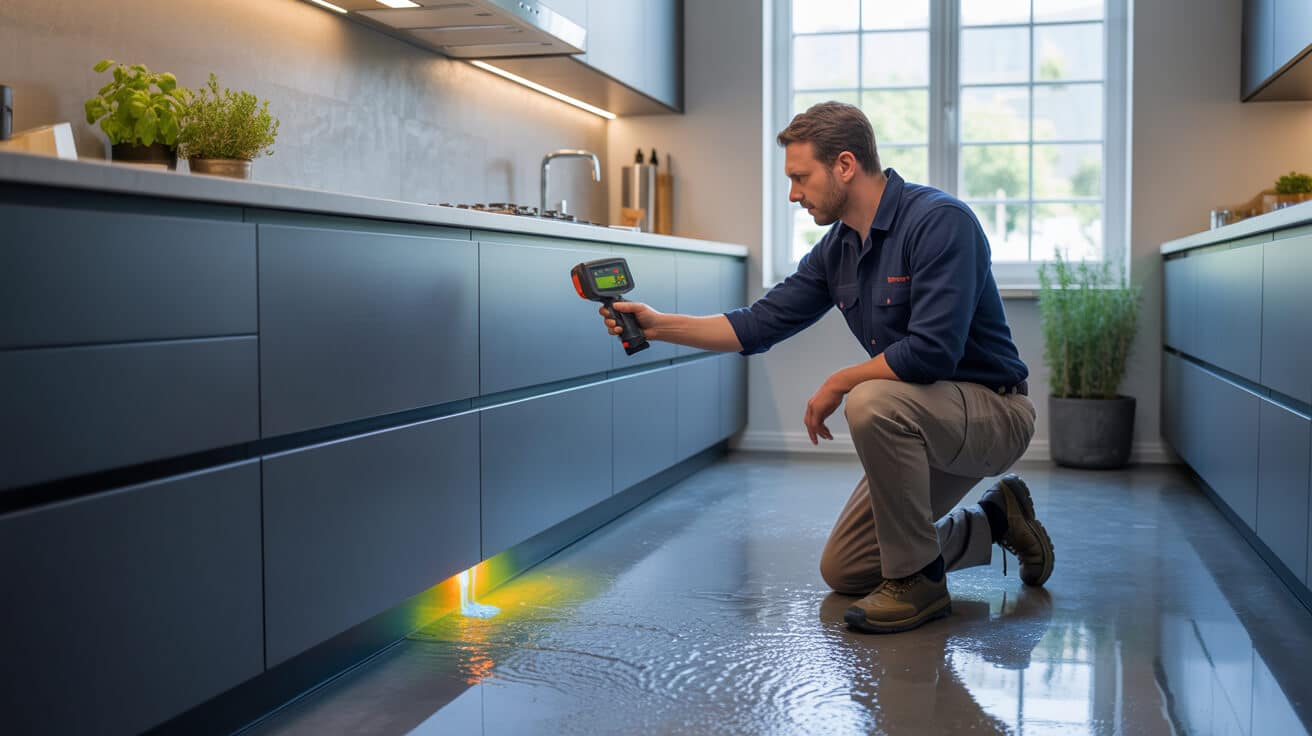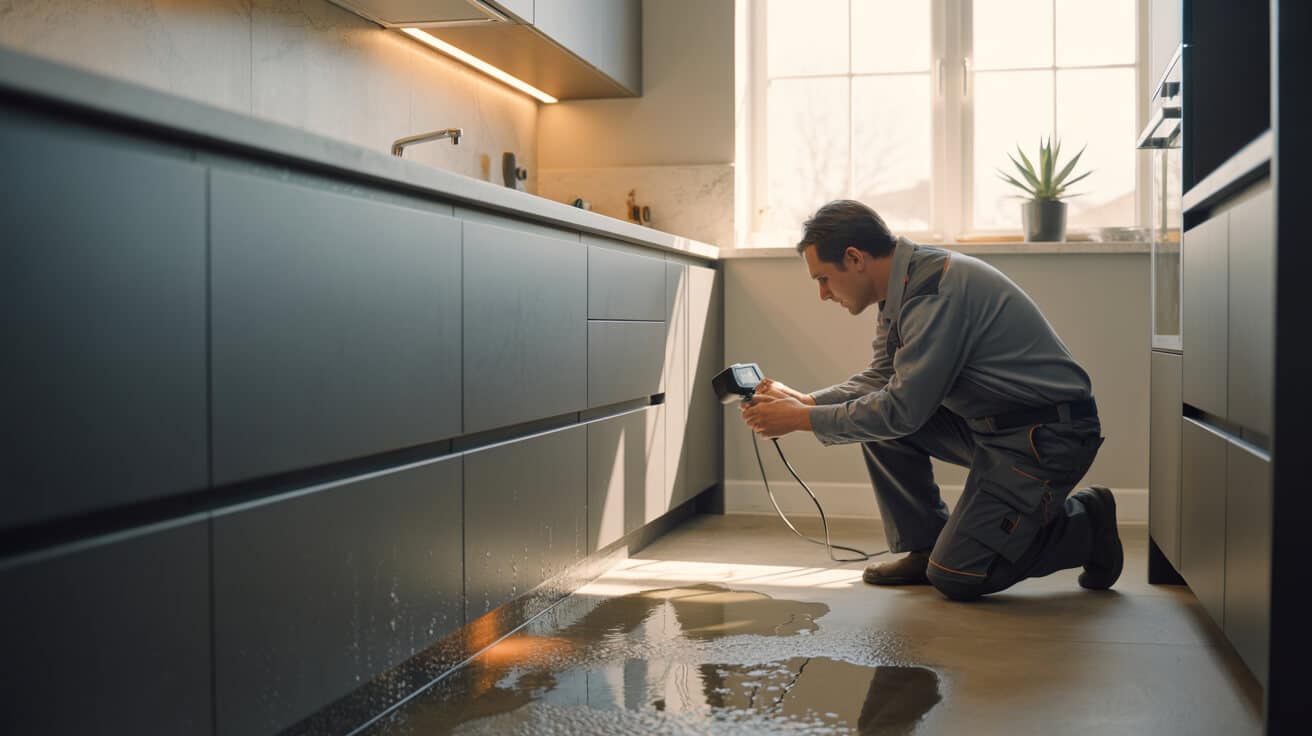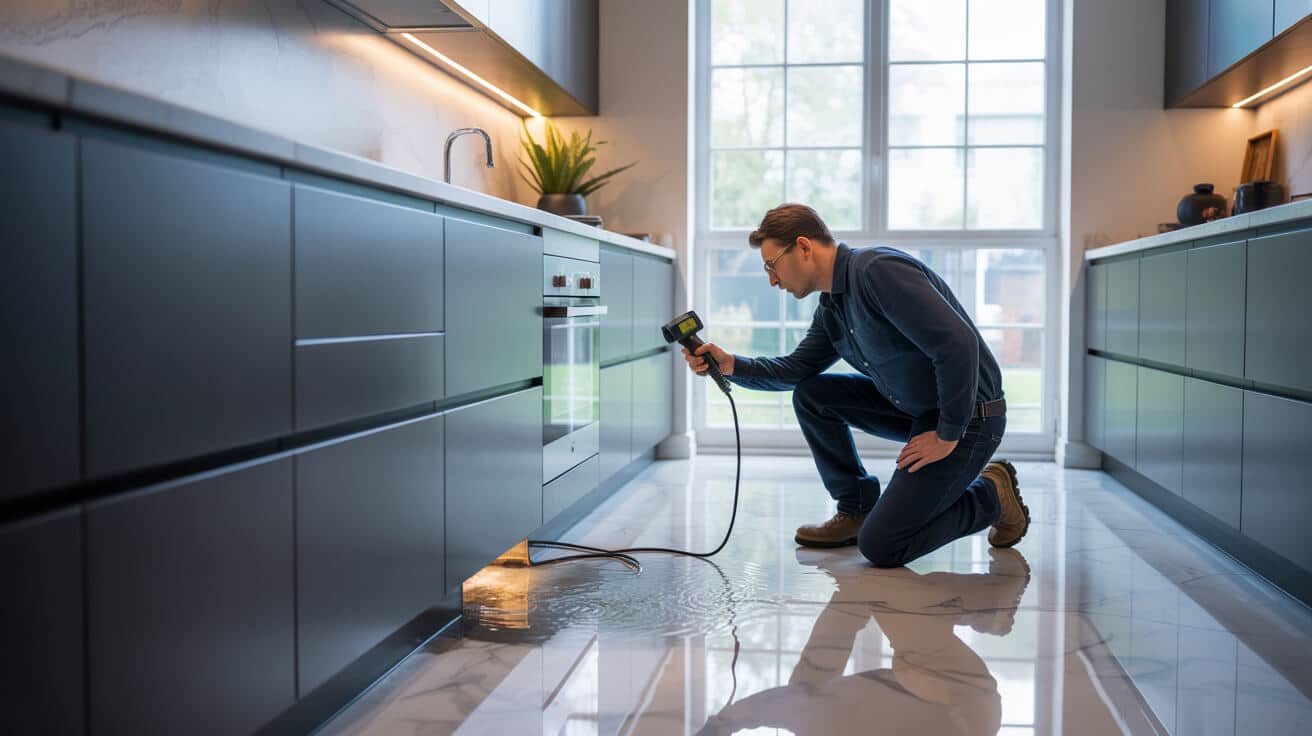Contemporary building construction increasingly integrates radiant heat beneath various floor coverings, prompting an evolution of detection approaches for faults invisible to the naked eye. The complexities introduced by screed, timber, and hybrid substrates demand a fusion of non-invasive diagnostics and technical expertise. Effective leak detection is critical for risk mitigation, energy efficiency, and the preservation of interior aesthetics, underpinning both homeowner assurance and commercial facility continuity.
Etymology or name origin
The phrase “underfloor heating” is rooted in practices developed to enhance ambient comfort by introducing heat emitters beneath flooring materials, a custom with historical antecedents in Roman hypocausts and East Asian ondol. “Leak detection” emerged with the proliferation of pressurised plumbing systems, referring to both the process of uncovering unwanted fluid escape and the tools supporting such identification. Over time, industry nomenclature distinguished between “wet” (hydronic) and “dry” (electric) systems, reflecting the underlying mechanisms of heat transfer and the nature of diagnostic challenges.
Overview and context
Radiant floor heating manifests as a grid or loop of pipes or cables installed underneath room finishes, distributing warmth evenly through conduction and convection. The appeal lies in unobtrusive comfort, improved air quality, and alignment with modern energy targets. However, the inaccessibility of embedded systems introduces a spectrum of possible leak-induced disruptions, ranging from slow performance degradation to sudden, catastrophic water ingress. System vulnerability typically arises from construction errors, mechanical stress, ageing, or accidental penetration, prompting property owners, landlords, and commercial asset managers to prioritise proactive leak management as part of essential infrastructure maintenance.
System types in buildings
- Hydronic systems: Water circulates through closed-loop piping made from cross-linked polyethylene (PEX), multilayer composites, or occasionally metal. Ideal for integration with efficient boilers or heat pumps.
- Electric systems: Resistance cables or mats beneath the surface provide direct thermal output; though immune to fluid leaks, these systems can be compromised by moisture ingress or physical damage.
- Zoned and hybrid layouts: Large installations may utilise both water-based and electric elements or divide spaces into multiple independently controlled heating zones.
Common risk factors for embedded leakage
- Pipe or cable joint fatigue
- Poor workmanship or substandard materials
- Mechanical damage from fasteners, drilling, or renovation
- Subfloor movement in timber, older, or poorly-compacted substrates
- Long-term chemical corrosion or scale deposition
Role in energy efficiency and comfort
The consistent heat delivered by underfloor systems improves overall energy performance, especially in air-tight building envelopes. However, even small leaks undermine anticipated savings by forcing compensatory system operation, increasing water and fuel consumption, and risking damage to insulation or floor coverings.
History
Origins and early systems
Incipient forms of radiant floor heating were deployed in ancient civilizations, capitalising on the principles of convective heat exchange. Roman and Korean systems harnessed heated air for architectural comfort, though maintenance and diagnostics remained crude and entirely reactive.
Development of detection methodologies
The advent of pressurised hydronic systems in the 20th century introduced new risks, leading initially to leak diagnosis by physical observation or rudimentary listening pipes. By the 1970s, professional plumbers began to experiment with thermal mapping, while the rise of electronic pressure testing allowed more consistent identification of hidden fails.
Recent technological advances
Modern diagnostics incorporate high-sensitivity thermal imaging, tracer gas detection, and acoustic analysis, enabling engineers to localise faults without the invasive lifting of flooring or screed. The rising expectation of near-instant case assessment in both residential and commercial environments has prompted ongoing innovation and integration with other building diagnostic measures.

Concepts and principles
Leak mechanisms in embedded pipework
A leak arises when the integrity of a pipe or joint is breached, allowing pressurised water or heat-transfer fluid to escape into surrounding substrate. Causes include:
- Material fatigue or faulty installation at connectors and bends
- Physical puncture or abrasion from accidental drilling or movement of furniture
- Erosion caused by misaligned system pressures or aggressive water chemistry
- Expansion and contraction cycles in inadequately secured pipes
Hydronic vs electric circuit vulnerabilities
- Hydronic circuits risk water escape, pressure loss, and progressive floor damage; detection is made complex by the slow movement of water through porous screed or insulation.
- Electric networks, while safe from leaks, can short-circuit if exposed to moisture; failures here are detected electrically rather than physically.
Pressure, moisture, and heat loss dynamics
An active leak creates a pressure differential between the system and ambient environment, triggering symptoms such as noisy system operation, uncommanded refilling, uneven zone performance, or unexplained damp.
Detection theory: tracing sources, mapping spread
Optimal detection combines multiple data signals—thermal variance, acoustic emission, gas diffusion, and volumetric pressure assessment—to separate ordinary degradation from actionable leaks. This multivariate confirmation underlies the most reliable maintenance protocols.
Detection methodologies
Initial non-destructive assessment
A trained engineer begins with symptom review—boiler pressure transients, cold spots, or visible subfloor stains—cross-referenced against system schematics and recent maintenance history. Visual checks prioritise subtle colour shifts, warped skirting, or early signs of mould, while discussions with property stakeholders clarify the chronology and impact of the observed issue.
Technical diagnostic tools
Thermal imaging
Infrared thermography visualises subfloor temperature anomalies; a cooled patch relative to surrounding zones points toward water migration below the surface. Efficacy increases when environmental heating enables sharp contrasts to be captured in thermal overlays.
Acoustic listening devices
Highly sensitive microphones detect the low-frequency vibrations produced by water escaping under pressure, particularly pronounced in periods of active heating. Engineers scan grids along suspect zones, triangulating the probable epicentre of the leak.
Moisture mapping and metres
Handheld or wall-inserted devices quantify the presence and direction of migrating water, differentiating between new and old events and establishing the extent of required remedial action.
Tracer gas injection
By substituting water with an inert, lighter-than-air gas such as hydrogen or a proprietary mix, an engineer can use a portable detector to sense emergent gas at floor level—bypassing the masking effects of water pooling or absorption within thick concrete.
Pressure loss and isolation testing
Isolating system loops one-by-one, engineers monitor pressure decay rates under controlled conditions, revealing whether leaks are localised within particular zones or circuits.
Borescope or endoscope approaches
As a last resort, a small-diameter camera is inserted through a drilled pilot hole, permitting visual confirmation of substrate saturation, pipe alignment, and sometimes the precise break site.
Comparative strengths and limitations
| Method | Invasiveness | Best used for | Limitation |
|---|---|---|---|
| Thermal Imaging | None | Screed floors, broad | Carpeted/timber floors |
| Acoustic Listening | None | Active, pressured leaks | Noisy environments |
| Tracer Gas | Low | Complex/cold floors | Well-sealed cavities |
| Moisture Metres | Low | All subfloors | Surface drying tricks |
| Borescope | Medium | Obscure/complex faults | Requires access drilling |
Tools and instruments
Non-destructive diagnostic equipment
- Infrared cameras: Advanced imaging provides rapid, non-destructive subfloor scanning; Plumbers 4U field engineers select sensor type based on finish material and system depth.
- Digital moisture metres: Calibrated for distinct substrate types, facilitating efficient moisture profiling.
Measurement and analysis devices
- Acoustic detectors: Fine-tune leak location where auditory signals are not masked by mechanical system noise.
- Pressure gauges: Both manual and digital, used for progressive isolation and quantitative decay recording.
- Tracer gas kits: Supply, control, and detect gas emissions safely and reliably within pressurised loops.
Consumables and repair parts
- WRAS-certified couplings and valves: Maintain regulatory compliance and system integrity after repair.
- Engineered pipe joiners and sealants: Used for both temporary patching and full mechanical remediation.
- Adhesives and specialist compounds: Specified according to system temperature and pressure requirements.
Comparative guide to equipment use
| Equipment | Function | Usage Context |
|---|---|---|
| Thermal Camera | Surface temp mapping | All opaque subfloors |
| Moisture Metre | Water directionality | Extent of migration |
| Acoustic Listener | Leak pinpointing | Pressurised operation |
| Tracer Gas System | Leak tracing | Non-responsive zones |
| WRAS Fittings | Post-repair compliance | Final system sign-off |
Stakeholder roles
Homeowners and residents
Your early attention to heating performance anomalies, water usage spikes, or subtle property changes enhances system resilience and reduces harm from undetected leaks. Professional intervention minimises disruption and secures effective remediation.
Landlords and property managers
Legal, insurance, and reputational imperatives require demonstration of timely, certified action when tenant heating or safety is affected. Combined with effective documentation, your proactive response preserves asset value and regulatory status.
Commercial facility directors and teams
Routine system checks and prompt escalation of operational complaints increase uptime, reduce operational risk, and extend capital outlay intervals. Coordinated workflows with detection specialists are essential for large premises.
Engineering and plumbing professionals
Engineers, such as those employed by Plumbers 4U, orchestrate complex diagnostics and repair, combining technical proficiency with regulatory documentation. Your expertise builds trust with occupants and property stakeholders.
Bodies such as CIPHE and WaterSafe audit qualification, procedural compliance, and repair outcomes. Warranty frameworks are maintained only when your chosen tradespeople meet or exceed standards for leak remediation and system care.
Insurers and claims adjusters
Your insurer requires extensive reporting—photos, test logs, chain-of-custody documents—both to validate loss claims and to forecast potential risks in the future. Communication with claims teams benefits from the use of structured, industry-standard forms.

Legal, regulatory, and warranty considerations
Building regulations and regional codes
Heating systems in the United Kingdom must comply with national regulations, including G3 for unvented cylinders and Part L for energy efficiency. Regional codes may further specify installation, maintenance, and documentation standards to which your company must adhere.
WRAS approval and materials
Leak repairs must be performed with materials and components holding current WRAS (Water Regulations Advisory Scheme) certification, ensuring suitability for potable water and minimising the risk of legal challenge.
Organisational frameworks
Trade organisations, including the Chartered Institute of Plumbing and Heating Engineering and WaterSafe, maintain qualification and best-practice standards for all companies operating in the sector, such as Plumbers 4U. Only tradespeople with these credentials may conduct certified leak repairs or sign off on insurance work.
Insurance protocols
You are required to submit thorough documentation of leak cause, detection process, repair measures, and post-repair testing for coverage eligibility. Timely and complete records accelerate claim settlement and protect your longer-term policy status.
Repair validation and documentation
Certified engineers provide commissioning certificates, test logs, and photographs with all completed repairs for your record-keeping and regulatory compliance. Maintaining this chain of evidence is vital to future claims or transfer of property.
Functionality, purpose, and applications
Preventative maintenance
Systematic leak detection supports a broader asset management strategy, enabling you to avoid expensive emergency repairs and disruption through early warning of developing faults.
Workflow in residential and commercial settings
Your detection process commences with system survey, symptom confirmation, and application of sequential diagnostics to localise the fault. Routing, ordering, and scheduling of interventions minimise disruption and adapt to the needs of your household or enterprise.
Emergency intervention
Designated emergency protocols guide the transition from ordinary maintenance to rapid response, restoring safe heating and safeguarding floor structure in your organisation or home environment.
Integration with service cycles
Leak detection operates most effectively when embedded within regular system checks, boiler servicing, and seasonal commissioning procedures, streamlining your ongoing facilities management.
Classifications and system types
Hydronic (wet) underfloor heating
Water-dependent loops use modern PEX, multilayer, or copper pipes, pressurised for efficiency and responsive control. Risk of gradual leak development persists at joints, connectors, or in substrate transition zones.
Electric (dry) underfloor heating
Solid-state mats or cable arrays require separate detection and repair protocols, with insulation resistance testing preferred over audible or thermal mapping.
Hybrid and zoned systems
Large commercial installations, multi-floor developments, and smart homes may include both hydronic and electric elements, delivering zone-specific performance but increasing diagnostic and repair complexity.
Subfloor typologies
Concrete screed permits the most effective surface scanning, timber or floating floors can trap and mask water movement, and composite or insulated bases may delay symptom recognition.
Performance metrics and data
Diagnostic efficiency
Key performance indicators include diagnosis-to-repair interval, localization accuracy, and the reduction of unnecessary floor damage, validated in after-action reviews and property surveys.
Cost variables
Your total expense is influenced by the nature of the leak, the finish material overhead, accessibility, and insurance policy coverage for restoration. Preventative interventions and early detection consistently yield the lowest overall costs.
Energy and resource conservation
Successful and early intervention curbs unnecessary water loss, preserves insulation R-values, and ensures the design energy efficiency is realised in your property.
Challenges, barriers, and limitations
Complexity of concealment
Multiple finishing layers and diverse building practices complicate access and readings. Your solution requires adaptive, case-specific selection of detection technologies.
Access and disruption
In some cases, precise detection still mandates limited, targeted disturbance of finished floors; minimising this requirement is a focus of all best-in-class service providers.
System design and installation legacy
Historical practice, untraceable older systems, and out-of-date materials or methods challenge detection effectiveness and necessitate invasive approaches.
Property type variability
Your experience will vary depending on the structure: older conversions, high-rise developments, and managed portfolios exhibit greater diagnostic risk and complexity.
Occupant and process disruption
Complex diagnosis can demand temporary relocation, alternative heating provision, and sequenced restoration, particularly in commercial contexts.
Impact, influence, and legacy
Asset protection
Comprehensive leak detection ensures system longevity, protecting both the structure and your investment.
Resource stewardship
Conserving water, energy, and building materials supports environmental objectives and utility savings within your operations or household.
Customer assurance and professionalism
By partnering with accredited engineers, such as those at Plumbers 4U, you benefit from advances in technical proficiency, process transparency, and documented service delivery.
Regulatory advancement
Industry shifts toward mandatory documentation, proactive management, and continuous improvement enhance the reputation of your organisation and the sector.
Risk management
Through rigorous detection protocols and robust reporting, your property and compliance profile remains optimised for future insurance events and regulatory checks.
Future directions, cultural relevance, and design discourse
Advancements in materials, diagnostic algorithms, and process standardisation continue to refine leak detection. Professional accreditation, evolved training programmes, and heightened awareness among property owners and maintenance stakeholders ensure a growing focus on prevention and holistic asset management. The trend toward transparent, customer-centred documentation—exemplified by firms like Plumbers 4U—reshapes industry norms and elevates your expectations regarding service quality, system resilience, and the safety of the spaces under your care or ownership. Evolving policies, technical innovation, and greater public understanding collectively reinforce leak detection not merely as a technical fix, but as a linchpin of responsible, future-ready building management.

